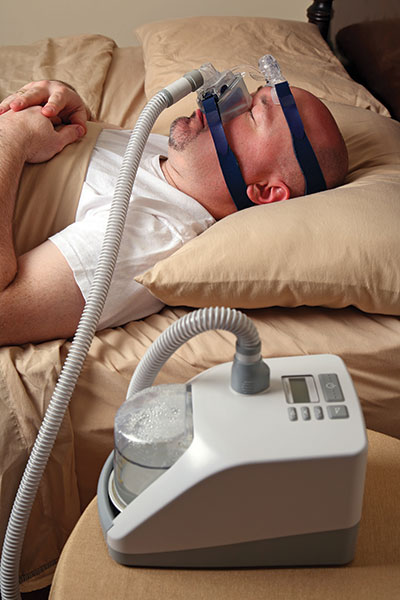This article is from the Winter 2015 issue of The Quill. To view the full issue, visit The Quill archive.

CPAP machines and other remedies commonly used for treatment have evolved over the years and are now more portable and comfortable.
FMCSA regulation 49 C.F.R. 391.41(b)(5) states that a person is physically qualified to drive a commercial motor vehicle if that person has no established medical history or clinical diagnosis of a respiratory dysfunction likely to interfere with his or her ability to control and drive a commercial motor vehicle safely. According to the Medical Examiner Handbook, this means the medical examiner has to determine whether a driver has a respiratory disease or disorder that increases the risk for sudden death or incapacitation, thus endangering public safety.
In 2013 President Obama signed a bill requiring the FMCSA to go through the formal notice and comment rulemaking process for any regulations regarding sleep apnea screening. Recently, the medical evaluation criteria for sleep apnea were removed from the FMCSA regulatory guidance; therefore, there are no regulations that currently exist, other than the information in the preceding paragraph.
Some physicians who have been trained prior to the removal of the guidance are inadvertently medically disqualifying a driver and causing them to have a sleep study because they meet one of the criteria, such as a BMI greater than or equal to 30, neck size over 17 inches (men) or 15 inches (women), complaints of loud snoring, etc. In reality, drivers need to meet multiple criteria to be disqualified. In addition, sleep apnea can strike anyone at any age, including children and physically fit and slender individuals. Unfortunately, physicians who are currently being trained may be educated under the rescinded FMCSA guidance.
It has been reported that since the guidance has been removed, physicians are afraid of opening themselves up to liability if they qualify a driver who has sleep apnea. Therefore, they are erring on the side of caution and requiring a sleep study if any of the criteria are met. Medical certification depends on a comprehensive medical assessment of overall health and informed medical judgment about the impact of single or multiple conditions on the whole person.
How is sleep apnea measured?
The severity of sleep apnea is measured against the Apnea–Hypopnea Index (AHI). The number represents the frequency of apnea and hypopnea events per hour of sleep where the patient stops breathing during sleep.
- Normal: 0-4
- Mild sleep apnea: 5-14
- Moderate sleep apnea: 15-29
- Severe sleep apnea: 30 or more
Without the guidance, physicians may wait to issue a diagnosis of sleep apnea until the driver has an AHI of 20. Even though this is considered moderate, it means the driver has 20 non-breathing episodes per hour where he or she stops breathing for at least 10 seconds or longer. This causes the person to unknowingly wake up hundreds of times per night, combined with a loud snore which is caused by the gasping of breath. This process does not permit the driver to reach the restorative REM sleep needed. As a result, the driver is tired the next day.
Managing the risk of sleep apnea
Protective encourages motor carriers to make sure their drivers and other employees, especially dispatchers, are aware of the signs of possible sleep disorders and also are alert for any symptoms exhibited by your drivers. Symptoms that indicate a person may have sleep apnea include:
- Lack of quality sleep and lack of dreaming during sleep
- Choking or gasping during sleep
- Loud snoring
- Frequent urination at night
- Waking up with a dry throat
- Morning headaches
- Inability to concentrate on work or driving tasks
- Feeling irritable and sleepy throughout daytime or waking hours
- Behavioral problems such as mood swings or depression
- High blood pressure and one or more of the above listed medical conditions that are contributory factors for sleep apnea
- Shortness of breath
Include training on how to combat driver fatigue and drowsiness in your safety programs for new drivers and refresher courses for experienced drivers. The “Quick Sleeping Tips for Drivers” brochure by the National Institute for Occupational Safety and Health (NIOSH) is helpful and available to download at www.cdc.gov/niosh/docs/2014-150/.
Drivers and other workers who experience any signs of a possible sleep disorder should contact their family doctor, an occupational health clinic or sleep disorder clinic to have a physician evaluate them. It’s not uncommon for a person who has sleep apnea to be in denial of having it. CPAP machines and other remedies commonly used for treatment have evolved over the years and are now more portable and comfortable.
Sleep apnea is a highly treatable disorder. With appropriate therapy, and compliance to the therapy, drivers who suffer from sleep apnea will be addressing a significant risk for impaired performance on the job.
Learn more
For information on identifying and treating sleep disorders or to locate a sleep disorder clinic in your area, contact any of the following organizations:
National Sleep Foundation
(703) 243-1697
www.sleepfoundation.org
American Sleep Apnea Association
(888) 293-3650
www.sleepapnea.org
American Academy of Sleep Medicine
(630) 737-9700
www.aasmnet.org
A copy of the Medical Examiner Handbook can be found on the FMCSA website. It was written for medical examiners, however it will provide you with more in depth knowledge of the medical qualification process. It could even be used to help develop a portion of a return-to-work program and your written job description as it applies to the medical qualification process.